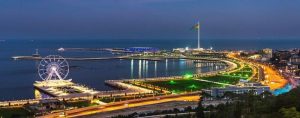
By Laman Ismayilova
In 2019, Baku Boulevard, a favorite vacation spot for capital residents and city guests, marks the 110th anniversary of its foundation.
In the past few years, Baku Boulevard has grown enormously, covering almost the entire inner part of the bay.
The length of the Seaside National Park, which previously was 16 km, reached 25 km after the major reconstruction.
Today it is one of the longest and most beautiful seaside parks in the world with an extensive infrastructure, unique green spaces, attractions, restaurants and cafes, various entertainments, sports, concert and shopping complexes.
Baku Boulevard remains one of the most popular places to spend time outdoors in the city.
The park is located along the shore of the Caspian Sea. The history of Baku Boulevard began in 1860, when the line of the fortress walls that went to Baku Bay was destroyed.
In 1865, at the request of the Baku military governor and head of the civil part Lieutenant General MP Kolyubakin, permission was given for the demolition of the fortress wall facing the sea, which “prevented the free movement of air by its uselessness”.
The proceeds from the sale of stone and the liberated territory between the old Fortress and the seashore were “used to build a pier and an elegant stone embankment, soon decorated with a number of beautiful private houses.”
Soon, architect Kasymbek Hajibababekov took up the construction of a stone embankment, for the construction of which the stones of the dismantled fortress wall were used.
Today Baku Boulevard is a place of cultural gatherings, celebrations, ceremonies, parades, and concerts.
Here you can find variety of activities for children and adults, shopping mall, cafes and restaurants and much more.
Park Bulvar Mall, a multi-storey shopping mall lies at the heart of all the action and activity.
The mall is located in 5 minutes walk from Sahil Metro station of Baku Subway and Government House of Baku.
The mall contains about 99 stores ranging from 50 square metres to 370 metres in size as well as hall movie theaters, planetarium and 3D cinema, bowling halls, food courts, etc. The first and second floors feature luxury shops and cafes.
Another famous activity of Baku Boulevard is a boat trip in Caspian Sea. Trips take place every 30 minutes.
The Baku Eye or the Ferris Wheel is a must-see on any sightseeing trip in the capital.
Officially opened in 2014 at Baku Boulevard, this 60m big wheel was built by the Dutch company Dutch Wheels.
The Baku Eye has 30 cabins, each holding 8 people. It makes a complete turn in 30 to 40 minutes.
National Flag Square, famous for the height is also located at Baku Boulevard.
A flag measuring 70 by 35 metres (230 by 115 feet) flies on a pole 162 m (531 ft) high.
The opening of the National Flag Square took place on September 1, 2010. At the President’s initiative, the National Flag Museum was also established and November 9 was declared the National Flag Day.
For some of the most breathtaking experience visit Baku Crystal Hall. One of the best concert halls is lighting up in eye-catching colors.
The diamond-faceted sports and concert venue was constructed on the territory of Baku’s National Flag Cluster specifically to host Eurovision Song Contest 2012 and the 42nd Chess Olympiad.
Marvelous building which opens up a magnificent view of the city is designed by the German company GMP and Swiss company Nussli International AG. The construction of three main components of the stadium (the arena, facade and roof) was launched in parallel at the same time.
The facade of building is equipped by the numerous modern dynamic LED lights which allow creating impressive lighting effects.
The total area of the complex is 30,958 sq. m. The corridor around arena is divided into two symmetrical parts with 15 entrances on each side including 30 outside entrances.
With a length of 230 and a width of 160 metres, the arena gives room to up to 27,000 spectators.
The walls of the building, covered with glowing crystals create an amazing visual effect with the play of light on it.
If you love visiting a new country and learning all about its history, then don`t miss the Stone Chronicle Museum.
The museum, located on the site of State Flag Square, was opened in 2015 by the Heydar Aliyev Foundation.
Many types of art works are put on display. Visitors may view historical development and evolution stages of the stone plastic arts in Azerbaijan through exhibits being displayed.
A trip to the capital wouldn’t be complete without seeing Azerbaijan Carpet Museum.
From 1967 to 1993, the museum was called the Azerbaijan State Museum of Carpet and Folk Applied Arts, from 1993 to 2014 – State Museum of Carpet and Applied Arts named after Latif Karimov, from 2014 to the present time the Azerbaijan Carpet Museum.
The museum has become a research-training and cultural-educational center where many events, such as exhibitions, international symposiums, and conferences, are held.
 Oval Useful news from Azerbaijan and Caucasus
Oval Useful news from Azerbaijan and Caucasus


